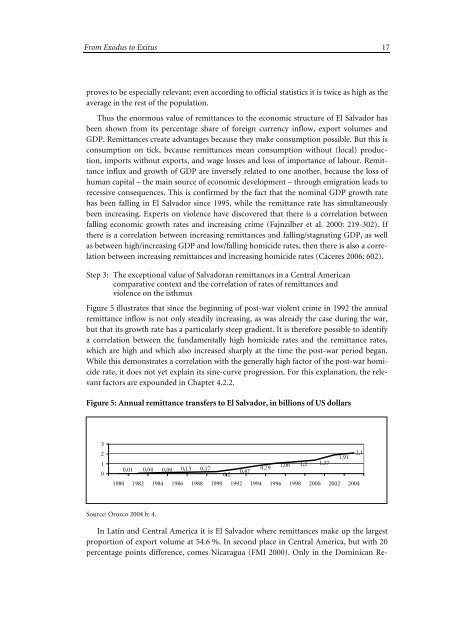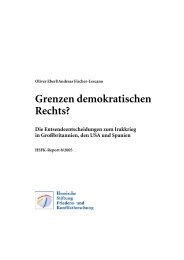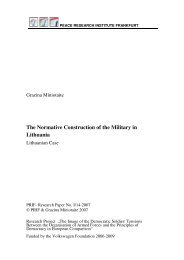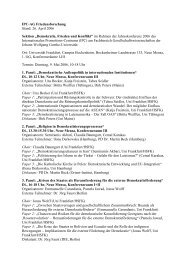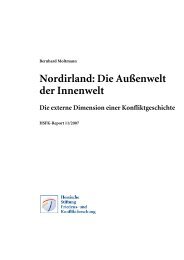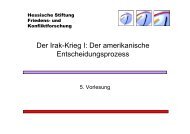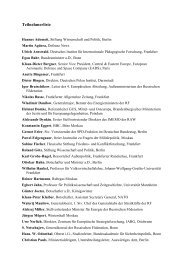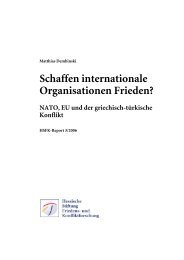From Exodus to Exitus Causes of post-war violence in El ... - eDoc
From Exodus to Exitus Causes of post-war violence in El ... - eDoc
From Exodus to Exitus Causes of post-war violence in El ... - eDoc
Create successful ePaper yourself
Turn your PDF publications into a flip-book with our unique Google optimized e-Paper software.
<strong>From</strong> <strong>Exodus</strong> <strong>to</strong> <strong>Exitus</strong> 17<br />
proves <strong>to</strong> be especially relevant; even accord<strong>in</strong>g <strong>to</strong> <strong>of</strong>ficial statistics it is twice as high as the<br />
average <strong>in</strong> the rest <strong>of</strong> the population.<br />
Thus the enormous value <strong>of</strong> remittances <strong>to</strong> the economic structure <strong>of</strong> <strong>El</strong> Salvador has<br />
been shown from its percentage share <strong>of</strong> foreign currency <strong>in</strong>flow, export volumes and<br />
GDP. Remittances create advantages because they make consumption possible. But this is<br />
consumption on tick, because remittances mean consumption without (local) production,<br />
imports without exports, and wage losses and loss <strong>of</strong> importance <strong>of</strong> labour. Remittance<br />
<strong>in</strong>flux and growth <strong>of</strong> GDP are <strong>in</strong>versely related <strong>to</strong> one another, because the loss <strong>of</strong><br />
human capital – the ma<strong>in</strong> source <strong>of</strong> economic development – through emigration leads <strong>to</strong><br />
recessive consequences. This is confirmed by the fact that the nom<strong>in</strong>al GDP growth rate<br />
has been fall<strong>in</strong>g <strong>in</strong> <strong>El</strong> Salvador s<strong>in</strong>ce 1995, while the remittance rate has simultaneously<br />
been <strong>in</strong>creas<strong>in</strong>g. Experts on <strong>violence</strong> have discovered that there is a correlation between<br />
fall<strong>in</strong>g economic growth rates and <strong>in</strong>creas<strong>in</strong>g crime (Fajnzilber et al. 2000: 219-302). If<br />
there is a correlation between <strong>in</strong>creas<strong>in</strong>g remittances and fall<strong>in</strong>g/stagnat<strong>in</strong>g GDP, as well<br />
as between high/<strong>in</strong>creas<strong>in</strong>g GDP and low/fall<strong>in</strong>g homicide rates, then there is also a correlation<br />
between <strong>in</strong>creas<strong>in</strong>g remittances and <strong>in</strong>creas<strong>in</strong>g homicide rates (Cáceres 2006: 602).<br />
Step 3: The exceptional value <strong>of</strong> Salvadoran remittances <strong>in</strong> a Central American<br />
comparative context and the correlation <strong>of</strong> rates <strong>of</strong> remittances and<br />
<strong>violence</strong> on the isthmus<br />
Figure 5 illustrates that s<strong>in</strong>ce the beg<strong>in</strong>n<strong>in</strong>g <strong>of</strong> <strong>post</strong>-<strong>war</strong> violent crime <strong>in</strong> 1992 the annual<br />
remittance <strong>in</strong>flow is not only steadily <strong>in</strong>creas<strong>in</strong>g, as was already the case dur<strong>in</strong>g the <strong>war</strong>,<br />
but that its growth rate has a particularly steep gradient. It is therefore possible <strong>to</strong> identify<br />
a correlation between the fundamentally high homicide rates and the remittance rates,<br />
which are high and which also <strong>in</strong>creased sharply at the time the <strong>post</strong>-<strong>war</strong> period began.<br />
While this demonstrates a correlation with the generally high fac<strong>to</strong>r <strong>of</strong> the <strong>post</strong>-<strong>war</strong> homicide<br />
rate, it does not yet expla<strong>in</strong> its s<strong>in</strong>e-curve progression. For this explanation, the relevant<br />
fac<strong>to</strong>rs are expounded <strong>in</strong> Chapter 4.2.2.<br />
Figure 5: Annual remittance transfers <strong>to</strong> <strong>El</strong> Salvador, <strong>in</strong> billions <strong>of</strong> US dollars<br />
3<br />
2<br />
1<br />
0<br />
Source: Orozco 2004 b: 4.<br />
0,01 0,04 0,09 0,13 0,17<br />
0,2<br />
1980 1982 1984 1986 1988 1990 1992 1994 1996 1998 2000 2002 2004<br />
In Lat<strong>in</strong> and Central America it is <strong>El</strong> Salvador where remittances make up the largest<br />
proportion <strong>of</strong> export volume at 54.6 %. In second place <strong>in</strong> Central America, but with 20<br />
percentage po<strong>in</strong>ts difference, comes Nicaragua (FMI 2000). Only <strong>in</strong> the Dom<strong>in</strong>ican Re-<br />
0,47<br />
0,79<br />
1,06<br />
1,2<br />
1,37<br />
1,91<br />
2,1


